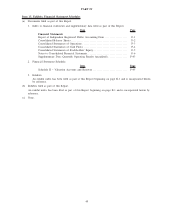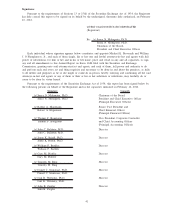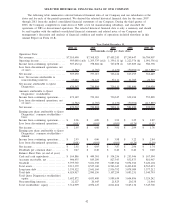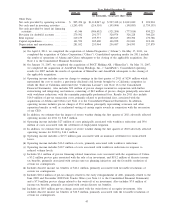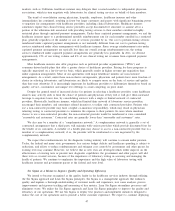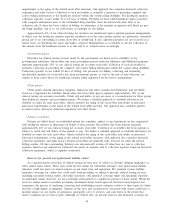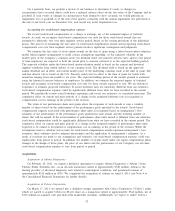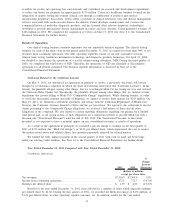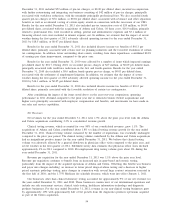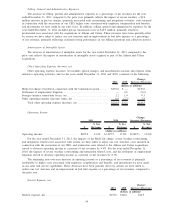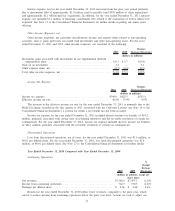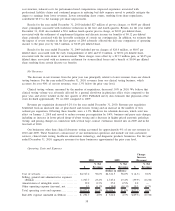Quest Diagnostics 2011 Annual Report Download - page 56
Download and view the complete annual report
Please find page 56 of the 2011 Quest Diagnostics annual report below. You can navigate through the pages in the report by either clicking on the pages listed below, or by using the keyword search tool below to find specific information within the annual report.requirements as the aging of the related receivables increases. Our approach also considers historical collection
experience and other factors. Collection of such receivables is normally a function of providing complete and
correct billing information to the healthcare insurers within the various filing deadlines. For healthcare insurers,
collection typically occurs within 30 to 60 days of billing. Provided we have billed healthcare plans accurately
with complete information prior to the established filing deadline, there has historically been little to no
collection risk. If there has been a delay in billing, we determine if the amounts in question will likely go past
the filing deadline, and if so, we will reserve accordingly for the billing.
Approximately 4% of our clinical testing net revenues are reimbursed under capitated payment arrangements,
in which case the healthcare insurers typically reimburse us in the same month services are performed, essentially
giving rise to no outstanding accounts receivable at month-end. If any capitated payments are not received on a
timely basis, we determine the cause and make a separate determination as to whether or not the collection of
the amount from the healthcare insurer is at risk and if so, would reserve accordingly.
Government payers
Payments for clinical testing services made by the government are based on fee schedules set by
governmental authorities. Receivables due from government payers under the Medicare and Medicaid programs
represent approximately 18% of our clinical testing net accounts receivable. Collection of such receivables is
normally a function of providing the complete and correct billing information within the various filing deadlines.
Collection typically occurs within 30 days of billing. Our processes for billing, collecting and estimating
uncollectible amounts for receivables due from government payers, as well as the risk of non-collection, are
similar to those noted above for healthcare insurers under negotiated fee-for-service arrangements.
Client payers
Client payers include physicians, hospitals, employers and other commercial laboratories, and are billed
based on a negotiated fee schedule. Receivables due from client payers represent approximately 36% of our
clinical testing net accounts receivable. Credit risk and ability to pay are more of a consideration for these payers
than healthcare insurers and government payers. We utilize a standard approach to establish allowances for
doubtful accounts for such receivables, which considers the aging of the receivables and results in increased
allowance requirements as the aging of the related receivables increase. Our approach also considers specific
account reviews, historical collection experience and other factors.
Patient receivables
Patients are billed based on established patient fee schedules, subject to any limitations on fees negotiated
with healthcare insurers or physicians on behalf of their patients. Receivables due from patients represent
approximately 21% of our clinical testing net accounts receivable. Collection of receivables due from patients is
subject to credit risk and ability of the patients to pay. We utilize a standard approach to establish allowances for
doubtful accounts for such receivables, which considers the aging of the receivables and results in increased
allowance requirements as the aging of the related receivables increases. Our approach also considers historical
collection experience and other factors. Patient receivables are generally fully reserved for when the related
billing reaches 210 days outstanding. Balances are automatically written off when they are sent to collection
agencies. Reserves are adjusted for estimated recoveries of amounts sent to collection agencies based on historical
collection experience, which is regularly monitored.
Reserves for general and professional liability claims
As a general matter, providers of clinical testing services may be subject to lawsuits alleging negligence or
other similar legal claims. These suits could involve claims for substantial damages. Any professional liability
litigation could also have an adverse impact on our client base and reputation. We maintain various liability
insurance coverages for claims that could result from providing, or failing to provide, clinical testing services,
including inaccurate testing results, and other exposures. Our insurance coverage limits our maximum exposure
on individual claims; however, we are essentially self-insured for a significant portion of these claims. While the
basis for claims reserves considers actuarially determined losses based upon our historical and projected loss
experience, the process of analyzing, assessing and establishing reserve estimates relative to these types of claims
involves a high degree of judgment. Changes in the facts and circumstances associated with claims could have a
material impact on our results of operations, principally costs of services, and cash flows in the period that
reserve estimates are revised or paid. Although we believe that our present reserves and insurance coverage are
50


